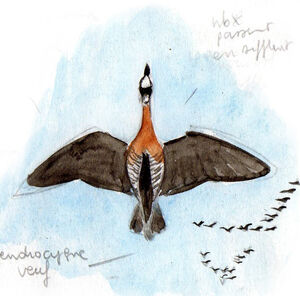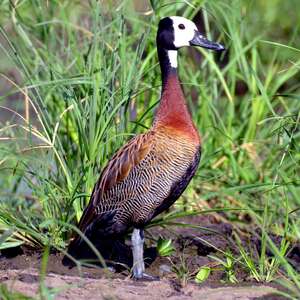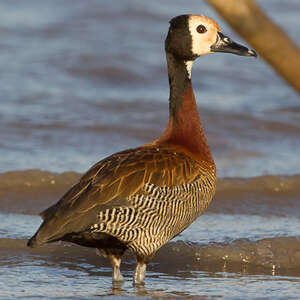White-faced Whistling Duck
Dendrocygna viduata - Dendrocygne veuf
Identification
The morphology of this long-legged Anatidae immediately identifies it as a White-faced Whistling Duck. Males and females look the same, but the female has slightly duller colors than the male. What immediately stands out in this bird is the strong contrast between the white face and the black back of the head. The neck, except for the upper part which is black and white like the head, and the upper chest are brown. A small black loop seems to hold the black hood near the throat. The rest of the body can be divided into three parts. A large black band runs from the chest to the tail included. Laterally to it, the sides are ocher, finely barred with black. Finally, the upper parts are brown with feathers widely edged in fawn. All this makes it an unmistakable bird. The forehead is sometimes ocher, this shade being able to take over the entire face in some individuals. These color variations depend on the region where the birds come from, and probably also on their feeding habits. In flight, the wings appear very dark, top and bottom. The species has a long black beak with a sub-terminal band of gray blue. The eyes are brown. The legs are gray blue.
The chick is dark brown above and yellow below. It has irregular spots on the sides. The head is dark with a light eyebrow and a pale line from the eye to the nape. The juvenile has the head, throat and lower parts whitish gray or ash gray. The chest brown is duller than in the adult. It acquires the white plumage of the head at 90 days and the adult plumage of the body at 180 days.
Subspecific information monotypic species
Foreign names
- Dendrocygne veuf,
- Suirirí cariblanco,
- dendrocisne-de-faces-brancas,
- Witwenpfeifgans,
- apáca-fütyülőlúd,
- Witwangfluiteend,
- Dendrocigna facciabianca,
- vithuvad visseland,
- Maskeplystreand,
- stromárka bielohlavá,
- husička vdovka,
- Nonnetræand,
- naamioviheltäjäsorsa,
- Nonnetjie-eend,
- ànec arbori carablanc,
- Randablístra,
- drzewica białolica,
- baltvaigu svilpējzoss,
- vdovski žvižgač,
- Белолицая древесная утка,
- シロガオリュウキュウガモ,
- 白脸树鸭,
- 白臉樹鴨,
Voice song and call
It is a noisy Anatidae. The most typical call of the White-faced Whistling Duck is a trisyllabic sound, swee-swee-sweeoo, lasting 1 to 2 seconds, emitted at takeoff, in flight and on landing as well as during feeding phases. It is also a repeated contact call at short intervals, often in chorus. In the event of an alert at the nest in the presence of ducklings, the adult emits a single wheee.
Habitat
The White-faced Whistling Duck occupies a wide variety of freshwater habitats, from sea level to 3,000 m altitude. It can be found on lakes, in wetlands and flooded plains, estuaries, artificial areas such as rice paddies, and along large rivers. During the nesting period, it prefers open wetland areas rich in reed beds and sandbanks, and well-stocked with vegetation. It can also frequent polluted waters such as those from sewage plants.
Behaviour character trait
The White-faced Whistling Duck is a gregarious and noisy duck. It gathers in large groups of several hundreds of individuals outside of the breeding season and easily mingles with other water birds, including congeneric species such as the Cape Teal in Africa or the Black-bellied Whistling Duck in South America.
It feeds, always in groups, mainly at dawn and dusk. With its adapted bill, it probes the mud, but also feeds at the surface of the water by dabbling. It also has no problem finding food on land. It can be active all night and rest during the hottest days while remaining very vigilant towards the intrusion of predators or humans. In case of danger, it stands still, upright on its legs and observes. If necessary, it quickly takes off to flee. Its large wings allow it to fly very comfortably, for example when travelling between rest sites and feeding sites. When they feed, groups remain very mobile and vocal. In the case of conflict within a group, the adopted attitude is head down stretched neck, the individuals jumping in place, wings open, and locking their beaks. The species is monogamous and the couple formed is for life. The partners spend a lot of time mutually preening their feathers.Flight
Dietfeeding habits
The White-faced Whistling Duck is mostly vegetarian, consuming herbs and seeds, particularly grasses and sedges, both wild and cultivated (rice, maize and sorghum) and during the rainy season also some aquatic invertebrates: molluscs, crustaceans and insects. Seasonal variations are observed. In the dry season, for example, it turns to more tubers.
Reproduction nesting
The breeding season begins with the rainy season and reaches its peak when rainfall is at its highest: the availability of insects is then at its maximum for the feeding of the young.
The White-faced Whistling Duck nests in isolated pairs or small groups. The nest is a simple depression in the ground near water, 16-18 cm wide and 5 cm deep. It is placed under dense vegetation to provide good protection against predators. It is made of vegetable elements. In South America, the species can occasionally nest in tree crevices. The female lays 4-13 eggs, rarely up to 16, white or pink, one per 24 hours. Incubation lasts 26-30 days and is provided by the couple. The male mainly incubates in the morning and in the evening. The ducklings are fed and protected from predators by both parents.Geographic range
The White-faced Whistling Duck breeds in Sub-Saharan Africa, where it is almost ubiquitous. It also breeds in Madagascar, where it is very abundant, and in the Comoros archipelago as well as on Mauritius and the Seychelles. It is also present over much of South America, and occasionally on Caribbean islands. It has been introduced in many regions of the world. It is sedentary, with some local movements caused by precipitation changes and the search for good feeding sites. But the movements do not exceed a few hundreds of kilometres. Migratory movements of the Madagascar population are poorly known.
Threats - protection
IUCN conservation status
concern
in the Wild
threatened
evaluated
The populations of White-faced Whistling Ducks are stable and the species is not globally threatened. They are abundant in Africa although they are hunted in large numbers locally, including during the breeding season. It is the most common duck in Madagascar. It does not seem to be subject to any conservation measures.
Sources of information
- IOC World Bird List (v15.1), Gill, F and D Donsker (Eds). 2025-12-07.
- The Birds of Africa Vol VIII : The Malagasy Region, Safford R. et Hawkins F.
- BirdLife International, BirdLife International
- HBW Alive,
- Birds of Southern Africa, Tony Roocroft
- Wikipedia (English version),
Other sources of interest
 Specification sheet created on
23/07/2023 by Nathalie Santa Maria
Specification sheet created on
23/07/2023 by Nathalie Santa MariaTranslation by AI Oiseaux.net
© 1996-2025 Oiseaux.net
- Accipitriformes
- Aegotheliformes
- Anseriformes
- Apodiformes
- Apterygiformes
- Bucerotiformes
- Caprimulgiformes
- Cariamiformes
- Casuariiformes
- Charadriiformes
- Ciconiiformes
- Coliiformes
- Columbiformes
- Coraciiformes
- Cuculiformes
- Eurypygiformes
- Falconiformes
- Galliformes
- Gaviiformes
- Gruiformes
- Leptosomiformes
- Mesitornithiformes
- Musophagiformes
- Nyctibiiformes
- Opisthocomiformes
- Otidiformes
- Passeriformes
- Pelecaniformes
- Phaethontiformes
- Phoenicopteriformes
- Piciformes
- Podargiformes
- Podicipediformes
- Procellariiformes
- Psittaciformes
- Pterocliformes
- Rheiformes
- Sphenisciformes
- Steatornithiformes
- Strigiformes
- Struthioniformes
- Suliformes
- Tinamiformes
- Trogoniformes
































